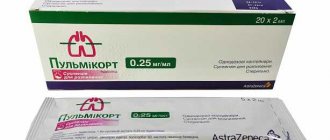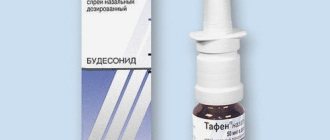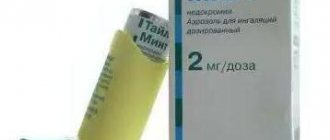Pharmacological properties of the drug Symbicort turbuhaler
Symbicort contains formoterol and budesonide (INN - budesonidum - budesonide), which have different mechanisms of action and exhibit an additive effect in reducing exacerbations of bronchial asthma. The specific properties of budesonide and formoterol make it possible to use their combination both for maintenance therapy and relief of symptoms, and as maintenance treatment for bronchial asthma. Budesonide is a glucocorticosteroid that, when inhaled, has a rapid (within a few hours) and dose-dependent anti-inflammatory effect on the respiratory tract, which leads to relief of symptoms and a decrease in the severity of exacerbations of bronchial asthma. Budesonide, given by inhalation, has less severe side effects than systemic corticosteroids. The exact mechanism of the anti-inflammatory effect of glucocorticosteroids is unknown. Formoterol is a selective β2-adrenergic receptor agonist. When inhaled, it leads to rapid and long-lasting relaxation of bronchial smooth muscle in patients with reversible airway obstruction. The bronchodilatory effect is dose dependent, the onset of action occurs within 1–3 minutes. The duration of the effect is at least 12 hours after using a single dose. Symbicort Turbuhaler Clinical effectiveness of maintenance therapy with Symbicort for bronchial asthma. Clinical trial results showed that adding formoterol to budesonide reduced asthma symptoms, improved lung function, and reduced the incidence of exacerbations. The effect of Symbicort Turbuhaler, prescribed to patients at a maintenance dose, on pulmonary function was consistent with the effect of budesonide and formoterol in individual inhalers in adults and exceeded the effect of budesonide in adults and children. Patients used short-acting β2-adrenergic agonists on demand. A decrease in the antiasthmatic effect over time was not noted. Clinical effectiveness in COPD. In two 12-month studies in patients with COPD, Symbicort Turbuhaler was superior to placebo, formoterol, and budesonide on lung function. There was also a significant reduction in exacerbations compared to placebo and formoterol. The treatment was well tolerated. Absorption. Symbicort Turbuhaler demonstrated bioequivalence with respect to the systemic effects of budesonide and formoterol. There were no signs of pharmacokinetic interaction between budesonide and formoterol. Pharmacokinetic parameters were compared after administration of budesonide and formoterol as formulations or as Symbicort Turbuhaler. Budesonide in aerosol form is rapidly absorbed and reaches maximum plasma concentration within 30 minutes after inhalation. Systemic bioavailability is approximately 49% of the administered dose. In children, the concentration in the blood plasma and deposition in the lungs has the same limits as in adults. Formoterol in aerosol form is rapidly absorbed and reaches maximum concentration in blood plasma within 10 minutes after inhalation. Systemic bioavailability is approximately 61% of the administered dose. Distribution and metabolism. Plasma protein binding is approximately 50% for formoterol and 90% for budesonide. The volume of distribution is approximately 4 L/kg for formoterol and 3 L/kg for budesonide. Formoterol is inactivated by conjugation reactions (active O-demethylated and deformylated metabolites are formed, which are mainly noted as inactivated conjugates). Budesonide undergoes significant (approximately 90%) first-pass biotransformation in the liver to metabolites with low glucocorticosteroid activity. The glucocorticosteroid activity of the main metabolites, 6β-hydroxy-budesonide and 16α-hydroxy-prednisolone, is less than 1% of the glucocorticosteroid activity of budesonide. There are no symptoms of metabolic interaction or substitution reactions between formoterol and budesonide. Excretion. The bulk of the dose of formoterol is eliminated by metabolism in the liver with further excretion through the kidneys. After inhalation, 8–13% of the administered dose of formoterol is excreted unchanged in the urine. Formoterol has a high systemic clearance (approximately 1.4 L/min) and its half-life averages 17 hours. Budesonide is eliminated by metabolism, which is mainly catalyzed by the CYP 3A4 enzyme. Budesonide metabolites are excreted in the urine unchanged or in conjugated form. A small amount of unchanged budesonide is noted in the urine with a high systemic clearance (approximately 1.2 l/min), with a plasma half-life of 4 hours on average. In children aged 4–6 years with bronchial asthma, the systemic clearance of budesonide is approximately 0.5 l/min. Based on 1 kg of body weight, children have a clearance approximately 50% higher than the clearance of adults. The half-life of budesonide in children after inhalation is about 2.3 hours. The pharmacokinetics of formoterol in children have not been studied. The pharmacokinetics of budesonide and formoterol in the elderly and patients with renal impairment are not known. The effect of budesonide and formoterol may be increased in persons with liver disease.
Indications for use
- bronchial asthma adequately controlled by inhaled β2-adrenomimetics and long-acting glucocorticosteroids (GCS), or insufficiently controlled by inhaled β2-adrenergic agonists and short-acting GCS - as treatment on demand; Symbicort Turbuhaler at a dosage of 80/4.5 mcg and 160/4.5 mcg can be used to relieve attacks and as maintenance therapy;
- Chronic obstructive pulmonary disease (COPD) is the symptomatic treatment of a severe form of the disease with a forced expiratory volume (FEV) less than 1/2 of the estimated calculated level, as well as a history of regularly recurring exacerbations, if signs of the disease persist despite treatment with long-acting bronchodilators.
Use of the drug Symbicort turbuhaler
The dose is selected individually depending on the severity of the disease. Once control of disease symptoms is achieved, the dose should be adjusted to the lowest dose that maintains effective control of symptoms. Bronchial asthma There are two alternative methods of treatment with Symbicort Turbuhaler. • Maintenance therapy and relief of symptoms with Symbicort Turbuhaler. (Attention! Prescribed only to adults over 18 years of age). Used as ongoing maintenance treatment and to relieve symptoms. Inhalations, used on demand, provide rapid relief of symptoms and improve control of asthma. Patients are advised to carry Symbicort Turbuhaler with them as first aid. A separate inhaler with a short-acting β2-adrenergic agonist drug is not required. Maintenance treatment and symptom relief with Symbicort Turbuhaler provides a reduction in severe exacerbations with supportive symptom control compared to maintenance therapy with Symbicort Turbuhaler in combination with a rapid-acting bronchodilator. Recommended doses: Depending on the severity of bronchial asthma, a dose of 80/4.5 mcg or 160/4.5 mcg can be used. Adults : 1 inhalation 2 times a day (morning and evening), or 2 inhalations once in the morning or evening. Some patients may be recommended 2 inhalations 2 times a day. If symptoms occur, patients should take an additional 1 inhalation. If symptoms persist after a few minutes, inhalation should be repeated. In any case, you can use no more than 6 inhalations in a row. The total daily dose usually does not exceed 8 inhalations, but temporarily a total daily dose of up to 12 inhalations can be used. • Maintenance therapy with Symbicort Turbuhaler: Used as continuous maintenance treatment in combination with a separate fast-acting bronchodilator, which is used as a first aid agent. Patients are advised to always carry a separate inhaler with a fast-acting bronchodilator. Recommended doses: depending on the severity of bronchial asthma, a dose of 80/4.5 mcg or 160/4.5 mcg can be used. Adults (over 18 years old) : 1–2 inhalations 2 times a day. In some cases, a maximum dose of 4 inhalations 2 times a day is necessary as a maintenance dose or as a temporary measure during intensifying attacks of bronchial asthma. Adolescents (12–17 years) : 1–2 inhalations 2 times a day. Children and teenagers (6–11 years old): Attention! Only a dose of 80/4.5 mcg twice daily is recommended. Increasing frequency of use of a single rapid-acting bronchodilator indicates worsening of the condition and requires a review of asthma therapy. COPD Adults: 2 inhalations (160/4.5 mcg/dose) 2 times a day. To achieve optimal results, patients should be instructed to use a maintenance dose of Symbicort Turbuhaler even in the absence of symptoms. There are no special dosing requirements for elderly patients. There are no data regarding the use of Symbicort in patients with hepatic or renal impairment. Since budesonide and formoterol are primarily eliminated by hepatic metabolism, the drug should be used with caution in patients with severe liver cirrhosis. Note. It is important to instruct the patient to adhere to the instructions for use;
inhale forcefully and deeply through the nozzle to ensure that the optimal dose reaches the lungs; never exhale through the nozzle; after use, close Symbicort Turbuhaler with a cap; Rinse your mouth with water after inhaling a maintenance dose to minimize the risk of developing oral candidiasis. When using the drug, the patient may not feel the taste of the drug, since a small amount enters the body.
Release form and composition
Symbicort Turbuhaler is available in the form of a dosed powder for inhalation, consisting of white or almost white granules, usually round in shape (dosage 80/4.5 mcg and 160/4.5 mcg - 60 or 120 doses each in plastic "turbuhaler" inhalers , in a cardboard pack there is 1 inhaler; dosage 320/9 mcg - 60 doses in plastic “turbuhaler” inhalers, in a cardboard pack there is one inhaler).
Composition of 1 dose (delivered):
- active ingredients: micronized budesonide - 80 mcg, 160 mcg or 320 mcg, formoterol fumarate dihydrate - 4.5 mcg (with budesonide 80 mcg and 160 mcg) or 9 mcg (with budesonide 320 mcg);
- auxiliary components: lactose monohydrate.
Side effects of the drug Symbicort turbuhaler
Since Symbicort Turbuhaler contains budesonide and formoterol, undesirable effects of varying types and degrees of intensity due to these substances may occur. After the concomitant use of these two components, no increase in the incidence of adverse reactions was noted. The most common side effects associated with the action of β2-adrenergic agonists are tremor and tachycardia (usually moderate and disappear within a few days after the start of treatment). Adverse reactions associated with the use of budesonide or formoterol are listed in the table.
Frequency | Systems and organs | Reaction |
| Common 1–10% | The cardiovascular system | Tachycardia |
| Disorders due to infection | Candidiasis of the oral cavity and pharynx | |
| Nervous system | Headache, tremor | |
| Respiratory system | Throat irritation, cough, hoarseness | |
| Undistributed 0.1–1% | The cardiovascular system | Tachycardia |
| Gastrointestinal tract | Nausea | |
| Musculoskeletal system | Convulsions | |
| Nervous system | Dizziness, agitation, nervousness, sleep disturbance | |
| Rare 0.01–0.1% | The cardiovascular system | Arrhythmias, eg atrial fibrillation, supraventricular tachycardia, extrasystole |
| The immune system | Immediate and delayed hypersensitivity reactions, such as dermatitis, exanthema, urticaria, pruritus and angioedema | |
| Respiratory system | Bronchospasm | |
| Skin and subcutaneous tissue | Bruising on the skin | |
| Very rare ≤0.01% | The cardiovascular system | Angina pectoris |
| Endocrine system | Signs or symptoms of systemic corticosteroid effects, such as adrenal hypofunction; hyperglycemia | |
| Nervous system | Depression, conduct disorder |
Mechanism of action and area of use
The active ingredients of the drug are the glucocorticosteroid Budesonide and the β2-adrenergic agonist Formoterol. Due to the hormone included in the drug, it can eliminate inflammatory phenomena. The second active substance selectively stimulates β2-adrenoreceptors, which are localized in the bronchi, heart, lungs, uterus, blood vessels and other internal organs.
As a result, there is an expansion of the lumen of the bronchi, relaxation of smooth muscles, a drop in blood pressure and an increase in heart rate.
When prescribed for asthma, Symbicort begins to act 1-3 minutes after inhalation and retains its effect for up to 12 hours.
In combination, both active substances reduce the symptoms of bronchial asthma, reduce the number of asthma attacks, and normalize bronchial function.
When inhaled, the glucocorticosteroid is quickly adsorbed, its maximum concentration is observed after half an hour. Up to 32%-44% of the inhaled dose reaches the lungs; in the systemic circulation these figures reach 49%. The beta2-agonist is absorbed even faster within 10 minutes.
From the initial dose, 28%-49% reaches the lungs, 61% enters the systemic circulation.
Both active substances undergo metabolic reactions in the liver and are excreted from the body through the kidneys. How the rate of excretion of active components from the body changes in citizens under 18 years of age, as well as in persons suffering from impaired renal function, is poorly understood. In citizens with liver pathologies, the rate of elimination of active substances slows down.
The drug Symbicort Turbuhaler is prescribed to people suffering from bronchial asthma and COPD. COPD stands for chronic obstructive pulmonary disease, which includes the following pathologies:
chronic obstructive bronchitis, including purulent bronchitis,- acquired pulmonary emphysema,
- high pressure in the pulmonary arteries,
- chronic enlargement of the right heart.
In patients suffering from bronchial asthma, the drug Symbicort is used as replacement therapy and to eliminate asthma attacks.
Symbicort for bronchitis with obstruction, as well as for other pathologies related to COLD, is prescribed when other long-acting drugs that dilate the bronchi do not help.
Restrictions on use
Symbicort is not prescribed:
- patients under 6 years of age, for Symbicort turbuhaler at a dosage of 320/9 mcg should not be used in persons under 12 years of age,
- if there is hypersensitivity to active and auxiliary components, including lactose.
Relative contraindications to the use of the drug are diseases such as:
various forms of tuberculosis,- respiratory system infections of various etiologies,
- hyperthyroidism,
- uncontrolled decrease in potassium in the blood,
- diabetes,
- severe arterial hypertension,
- severe pathologies of the heart and blood vessels,
- neoplasms that actively produce adrenaline or norepinephrine.
In addition, there is no reliable data on whether active substances penetrate the placental barrier and whether they have a negative effect on the fetus. Therefore, Symbicort during pregnancy is prescribed only according to strict indications and in minimally effective dosages.
It is also unknown whether the active ingredients penetrate into mother's milk, so the medication is prescribed as a last resort, when the rest are powerless.
If you cannot do without the use of medication during lactation, then it may be worth transferring the child to artificial nutrition.
With cirrhosis of the liver, the removal of active substances from the body may slow down.
There is insufficient data on the use of drugs in persons suffering from renal impairment of varying severity.
In patients of the older age group, the drug is used in normal dosages.
Special instructions for the use of Symbicort Turbuhaler
When stopping long-term treatment, it is recommended to gradually reduce the dose. Treatment should not be stopped abruptly. Sudden and progressive deterioration in control of asthma or COPD is potentially life-threatening and should be urgently assessed by a physician. In this case, the need for enhanced corticosteroid therapy, such as a course of oral corticosteroids or antibiotic treatment if infection is present, should be considered. You should not start using Symbicort Turbuhaler to treat severe exacerbations of the disease. It is necessary to monitor the effects on growth of children and adolescents who take various dosage forms of corticosteroids over a long period of time, and evaluate the benefits of therapy against the possible risk of growth inhibition. Particular attention is required in patients who are discontinuing treatment with oral steroids, as they may remain at risk of developing adrenal insufficiency for a long time. Patients who require high doses of emergency corticosteroid therapy or long-term use of the highest recommended doses of inhaled corticosteroids may also be considered at risk. Under extreme stress, these patients may experience signs and symptoms of adrenal insufficiency. During stress or planned surgical interventions, the need for additional systemic compensation with corticosteroids should be considered. Symbicort Turbuhaler is used with caution in patients with severe cardiovascular disorders, including cardiac arrhythmias, diabetes mellitus, untreated hypokalemia or thyrotoxicosis. High doses of β2-adrenergic agonists can reduce s-potassium levels, leading to a redistribution of potassium from the extracellular to the intracellular space by stimulating Na+/K+-ATPase in muscle fibers. The clinical significance of this effect is not precisely known. Symbicort Turbuhaler contains lactose (≤1 mg/inhalation), which is usually not dangerous for individuals with lactose intolerance. During pregnancy and breastfeeding. There are no clinical data regarding the use of Symbicort Turbuhaler or concomitant therapy with budesonide and formoterol during pregnancy. Studies of the toxic effect of this combination on the reproductive function of animals have not been conducted. There are no sufficient data regarding the use of formoterol during pregnancy. The use of high systemic doses of formoterol in animals was accompanied by reproductive side effects. Data from observations of women during pregnancy (2500 cases) using budesonide did not reveal an increase in teratogenic risk that would be associated with the use of inhaled budesonide. Symbicort Turbuhaler can be used during pregnancy, especially in the first trimester and shortly before childbirth, only after a thorough analysis of all factors. During pregnancy, use the lowest effective dose necessary to maintain adequate asthma control. It is not known whether budesonide or formoterol passes into breast milk. During breastfeeding, Symbicort is used when the expected benefit to the mother outweighs the possible risk to the child. Does not affect the ability to drive vehicles and other mechanisms .
Contraindications
Absolute:
- children under 6 years of age;
- children under 12 years of age (for a dosage form containing budesonide 320 mcg + formoterol 9 mcg);
- hypersensitivity to any of the components of the drug.
Relative (Symbicort Turbuhaler is used with caution):
- active or inactive forms of tuberculosis;
- the presence of viral, bacterial or fungal infections of the respiratory system;
- severe arterial hypertension;
- diabetes;
- thyrotoxicosis;
- aneurysm of any location;
- uncontrolled hypokalemia;
- pheochromocytoma;
- idiopathic hypertrophic subaortic stenosis;
- prolongation of the QT interval;
- severe heart failure;
- cardiac ischemia;
- tachyarrhythmia.
Drug interactions Symbicort turbuhaler
Pharmacokinetic The metabolism of budesonide is mediated by CYP 3A4, a subfamily of cytochrome P450. Inhibitors of this enzyme (ketoconazole) may increase the systemic exposure of budesonide. This fact has limited clinical significance for short-term (1-2 weeks) treatment with ketoconazole, however, it should be taken into account during long-term treatment with ketoconazole. Maintenance therapy and symptom management are not recommended for patients using potential CYP3A4 inhibitors. Pharmacodynamics Medicines with β2-adrenergic agonists (including eye drops) may weaken or inhibit the effect of formoterol. Interactions of budesonide and formoterol with any other drug used to treat asthma were not observed.
Drug interactions
If it is necessary to prescribe the drug with ketoconazole or other potent inhibitors of CYP3A4, the interval between doses should be increased as much as possible, as the plasma concentration of budesonide may increase.
Concomitant use with beta-blockers (including eye drops) is not recommended, as they may weaken the effect of formoterol.
When co-administered with disopyramide, phenothiazine, quinidine, procainamide, antihistamines, tricyclic antidepressants and monoamine oxidase inhibitors, the QTc interval may prolong and the likelihood of developing ventricular arrhythmias may increase.
Oxytocin, levothyroxine, ethanol and levodopa can reduce the tolerance of the heart muscle to β2-agonists.
With the simultaneous use of Symbicort Turbuhaler with procarbazine, furazolidone and monoamine oxidase inhibitors, an increase in blood pressure is possible; with xanthine derivatives, diuretics and mineral derivatives of corticosteroids - the hypokalemic effect of β2-adrenergic agonists may be enhanced; with other beta-adrenergic receptor agonists - an increase in the side effects of formoterol is possible.
When undergoing general anesthesia with halogenated hydrocarbons in patients taking Symbicort Turbuhaler, the risk of developing arrhythmias increases.
Budesonide does not interact with other drugs used to treat bronchial asthma.
Overdose of the drug Symbicort turbuhaler, symptoms and treatment
The use of formoterol at a dose of 90 mcg for 3 hours in patients with acute bronchial obstruction was safe. Acute overdose of budesonide when using high doses is unlikely. With prolonged use of high doses, the systemic effect of glucocorticosteroids may occur. Symptoms of formoterol overdose are typical for β2-adrenergic receptor agonists: tremor, headache, tachycardia. Hypotension, metabolic acidosis, hypokalemia and hyperglycemia may develop. Treatment is supportive and symptomatic.
Directions for use and doses
Symbicort Turbuhaler is not intended for the initial treatment of intermittent and mild persistent bronchial asthma.
The dose selection of the drugs included in Symbicort Turbuhaler is carried out individually and depending on the severity of the disease. This must be taken into account not only when starting treatment with combination drugs, but also when changing the dose of the drug.
If individual patients require a different combination of doses of active substances than in Symbicort Turbuhaler, beta2-adrenergic agonists and/or corticosteroids should be prescribed separately in separate inhalers.
Analogues of Symbicort
Analogues of Symbicort include:
- Serevent - manufacturer UK, inhaler for 120 doses, cost 3,700 rubles;
- Salbutamol – 200 doses, from a domestic manufacturer, cost 112 rubles;
- Ventolin - manufacturer France, inhaler for 200 doses, price 133 rubles;
- Berodual is an aerosol inhaler, cost 313 rubles.
We recommend reading about the main characteristics of the drug Salbutamol. From the article you will learn about the mechanism of action and indications for use, rules of use and dosage, analogues of Salbutamol. And here is more information about the instructions for use of the drug Ipraterol.
Symbicort is an effective drug for asthmatics that can be used as part of long-term maintenance therapy with minimal risk of side effects. It is used in pediatric practice, but only from the age of 6 years. Prescribed by a doctor, it belongs to the group of hormonal drugs, can be used for mild bronchial asthma and exacerbation of chronic obstructive pulmonary disease.







